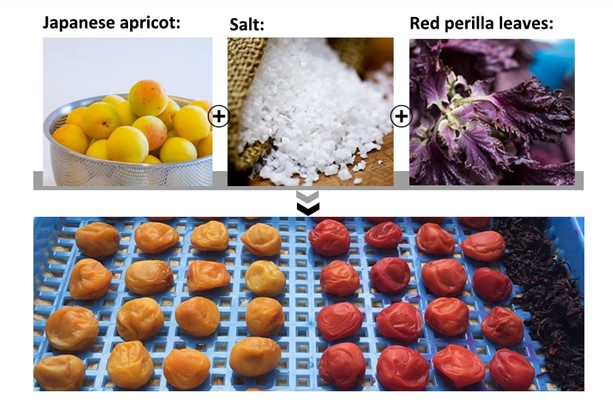Antioxidant content and activity are increased during the processing and digestion of Japanese apricots pickled with salted red perilla leaves
Shiso-zuke umeboshi, a traditional Japanese apricot pickle made with salted red perilla leaves, is known for its health-promoting properties due to its high content of phenolic compounds. These compounds, with antioxidant, anti-inflammatory, and antimicrobial properties, making it popular in both culinary and medical applications. Recent research focused on the quantitative and qualitative changes in phenolic profiles and antioxidant activity of Shiso-zuke Umeboshi during processing and digestion simulated in vitro. The study revealed significantly higher phenolic content during processing, with a gradual increase in antioxidant levels and activity observed throughout different stages of digestion, further supporting the health benefits of this pickling method.

Image title: Comparison of Processing Components and Red-Colored Shiso-Zuke Umeboshi with Control Group.
Image caption: Sampling was conducted at three stages: during simple salt pickling, after 30 days of pickling with salted perilla leaves, and after 60 days of pickling with salted perilla leaves. The resulting Shiso-zuke Umeboshi had a distinctive red appearance.
Image credit: Prof. Yukiharu Ogawa from Chiba University
Image license: Original content
Usage restrictions: Cannot be reused without permission.
The diverse biochemical composition of Japanese apricot fruits explains their broad spectrum of action on the human body. The high levels of key phenolic compounds and hydroxycinnamic acids contribute to various health benefits including anti-inflammatory, antioxidant, and antimicrobial properties.
A recent study published in Food Research International on July 19, 2024, led by Prof. Yukiharu Ogawa and Jutalak Suwannachot from Chiba University, quantitatively evaluated the changes in phenolic compounds and antioxidant activity during the production of Shiso-zuke Umeboshi (PP). The study also simulated the digestive process to characterize the release of these compounds and their antioxidant activity.
“Some of the benefits have been observed in pickling with red perilla (PP), but the current data are still limited. Many recent efforts have been focused on creating functional foods, which are designed to provide health benefits and essential nutrients in addition to the traditional micronutrients. However, there remains uncertainty regarding the specific effects of apricot pickled with red perilla (Shiso-zuke Umeboshi, PP). This motivated our study,” explains Prof. Ogawa.
In this study, the production of perilla-pickled apricots involved three methods: simple salt pickling (SP), pickling with salted perilla leaves for 30 days (30-PP), and pickling with salted perilla leaves for 60 days (PP). The pickle samples underwent ultrasonic-assisted treatment, after which the supernatants were extracted from the mixture by centrifugation to quantify free and esterified phenolics in the aqueous phase. The remaining residue was used to analyze the insoluble-bound phenolics in the organic phase.
All three phenolic fractions were assessed using liquid chromatography-mass spectrometry (HPLC-PDA-QDa), with a focus on their peak areas at 280 and 320 nm wavelengths.
The researchers evaluated total phenolic content (TPC) using the Folin-Ciocalteu reagent test. The Total flavonoid content (TFC) was determined via a 96-well microplate method combined with an aluminum chloride (AlCl3) colorimetric assay. Antioxidant activity was then assessed at 740 nm, with results expressed in millimoles (mmol).
The scientists modeled the gastrointestinal digestion of apricot pickles. They adjusted the sample’s pH to simulate the conditions of the different parts of the digestive tract. Next, digestive enzymes were introduced, and the digested fractions were filtered. The components were then identified, and their antioxidant activity was measured.
The HPLC chromatogram revealed rosmarinic, caffeic, p-coumaric, and ferulic acids as the main phenolic compounds detected. A comparative analysis of the three samples showed an increase in the concentration of bioactive compounds from the 30-day pickling stage (30-PP) to the finished product (PP). Among all phenolics, rosmarinic acid (RA) was the most predominant in all the samples. Ferulic acid was detected in smaller concentrations, particularly in esterified fractions that also showed higher levels of caffeic and p-coumaric acids. The lower concentration of ferulic acid is likely due to its low water solubility.
In the simulated in vitro digestion, differences between salt pickling (SP) and salt pickling with perilla (PP) were analyzed at various stages: before digestion (G0), 60 minutes after gastric digestion (G60), at the transition to intestinal digestion after 60 minutes (G60), and 120 min into small intestinal digestion (I120).
The highest release of bioactive compounds occurred at G0, while the lowest levels were observed at G60. However, a significant increase in bioactive compound release was noted between G60 and I120. At I120, both SP and PP showed the highest release of TPC and TFC. These results can be attributed to the influence of pH conditions and intestinal enzymes, which likely enhanced TPC and TFC levels.
For antioxidant activity, PP demonstrated a higher potential throughout the in vitro gastrointestinal digestion from 1 hour of gastric digestion through the final stage of small intestinal digestion, in contrast, SP exhibited a more steady trend. Overall, the acidic conditions during pickling appear to enhance the availability of RA and other perilla compounds.
“The health benefits of Japanese apricot pickles are mainly derived from the antioxidant compounds of the red perilla, which acts as both a natural food color and a health-promoting ingredient,” concludes the lead researcher Jutalak Suwannachot.
About Professor Yukiharu Ogawa
Yukiharu Ogawa is a Professor at the Graduate School and Faculty of Horticulture, Chiba University, Japan. He has previously held positions at National Food Research Institute in Tsukuba, the USDA Western Regional Research Center in California as a post-doctoral fellow, and at Kurashiki-Sakuyo University as a lecturer. The main area of his scientific work is agricultural and food process engineering, with a specific focus on food quality evaluation. His work aims to understand the impact of postharvest, food processing, and cooking procedures on the digestibility of processed food materials using simulated in vitro digestion techniques. He is also involved in developing long-term storage methods for fresh-cut vegetables and fruits monitored using atmospheric and lighting parameters.
Funding:
This study was supported by JSPS KAKENHI, Grant Number 21H023. The authors are thankful to Mitsubishi Corporation for granting the scholarship; JEES Sponsor-Crowned Scholarship for assisting the first author.
Reference:
Title of original paper: Changes in polyphenolic compounds and antioxidant activity of Japanese pickled apricot with salted red perilla leaf during pickling and digestion process
Authors: Jutalak Suwannachot 1 and Yukiharu Ogawa1
Affiliations: 1Graduate School of Horticulture, Chiba University, Japan
Journal: Food Research International
DOI: https://doi.org/10.1016/j.foodres.2024.114752.
Contact: Yukiharu Ogawa
Graduate School of Horticulture, Chiba University, Japan
Email: ogwy@faculty.chiba-u.jp
Public Relations Office, Chiba University
Address: 1-33 Yayoi, Inage, Chiba 263-8522 JAPAN
Email: koho-press@chiba-u.jp
Tel: +81-43-290-2018
Recommend
-

An insect and machine enthusiast delves into the flight mechanism of living organisms: From the mosquito flapping to the high-performance drones
2024.03.12
-

The Science Behind Nature’s Touch: Horticultural Therapy and Community Well-Being
2025.01.14
-

Solving Real-World Healthcare Challenges: The Power of Medical-Engineering Collaboration in Research and Education
2023.03.23

